Literature Review on Supply Chain Integration for MGMT6018 Students
VerifiedAdded on 2023/06/10
|12
|3407
|173
Literature Review
AI Summary
This literature review examines supply chain integration (SCI) as a crucial practice for enhancing supply chain quality management, drawing upon the work of Soares, Soltani, and Liao (2017) and other academic sources. The review explores the drivers of SCI, including global competition, technological advancements, and demand uncertainties, highlighting its importance for improving customer satisfaction and organizational performance. It discusses various perspectives on SCI, including its impact on inventory management, cost reduction, product quality, and competitive advantage. The review emphasizes the role of SCI in fostering collaboration, innovation, and efficient resource flow among supply chain partners. The assignment analyzes various studies and frameworks to show how SCI contributes to improved brand image, customer retention, and overall business success, while also acknowledging the complexities and challenges associated with its implementation, such as trust and cultural alignment. It uses examples like Wal-Mart and Zara to illustrate the practical implications of SCI, concluding that SCI is essential for centralizing control, enhancing collaboration, and improving supply chain activities.
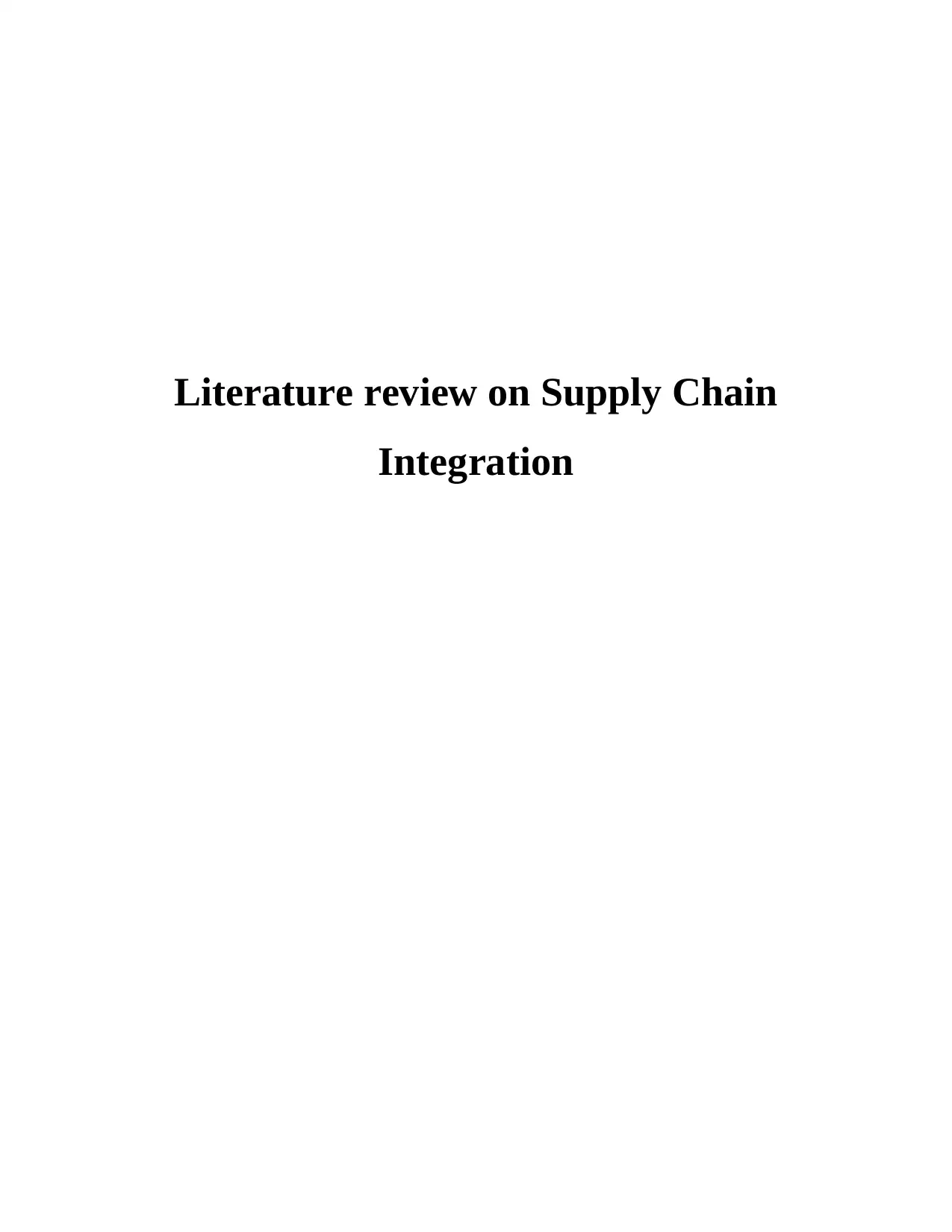
Literature review on Supply Chain
Integration
Integration
Paraphrase This Document
Need a fresh take? Get an instant paraphrase of this document with our AI Paraphraser
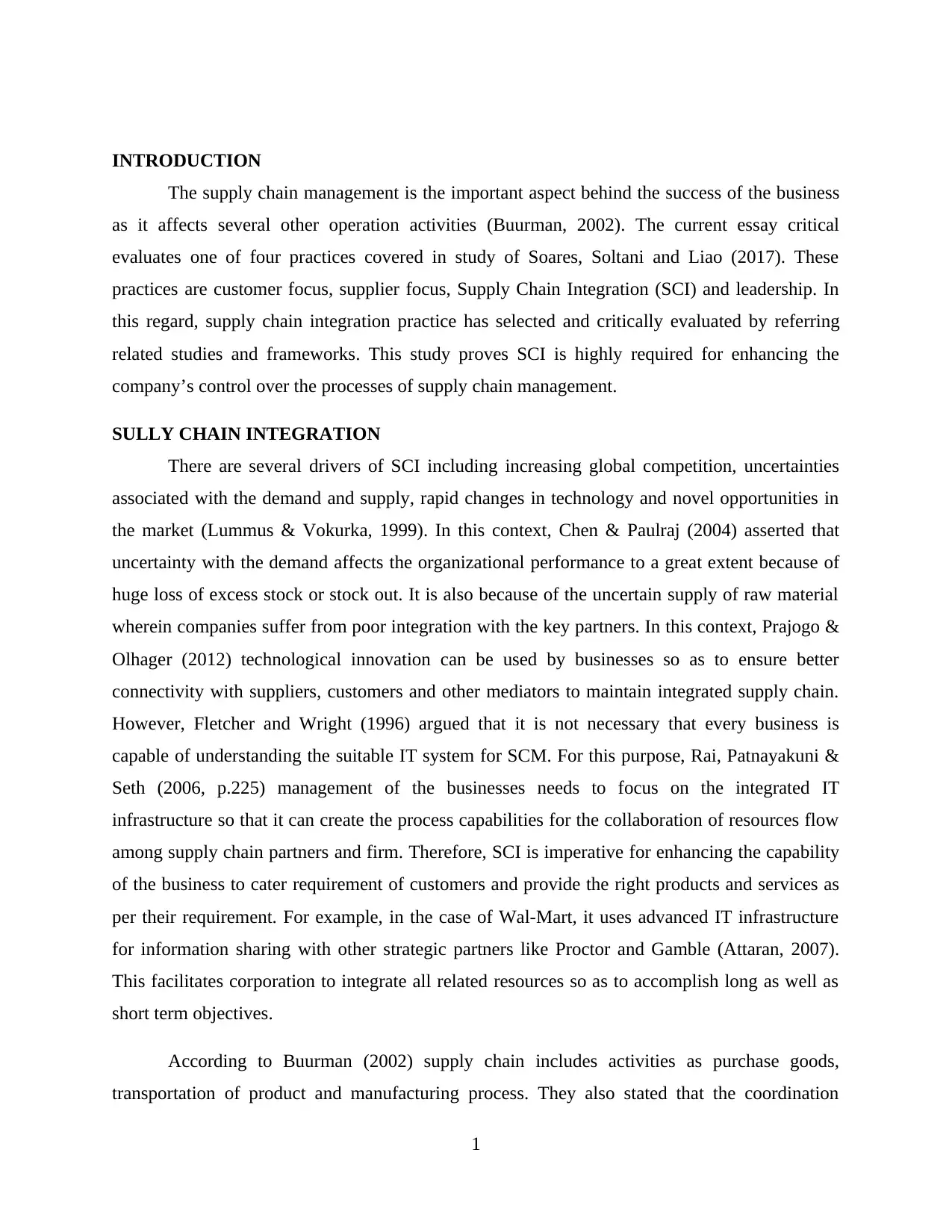
INTRODUCTION
The supply chain management is the important aspect behind the success of the business
as it affects several other operation activities (Buurman, 2002). The current essay critical
evaluates one of four practices covered in study of Soares, Soltani and Liao (2017). These
practices are customer focus, supplier focus, Supply Chain Integration (SCI) and leadership. In
this regard, supply chain integration practice has selected and critically evaluated by referring
related studies and frameworks. This study proves SCI is highly required for enhancing the
company’s control over the processes of supply chain management.
SULLY CHAIN INTEGRATION
There are several drivers of SCI including increasing global competition, uncertainties
associated with the demand and supply, rapid changes in technology and novel opportunities in
the market (Lummus & Vokurka, 1999). In this context, Chen & Paulraj (2004) asserted that
uncertainty with the demand affects the organizational performance to a great extent because of
huge loss of excess stock or stock out. It is also because of the uncertain supply of raw material
wherein companies suffer from poor integration with the key partners. In this context, Prajogo &
Olhager (2012) technological innovation can be used by businesses so as to ensure better
connectivity with suppliers, customers and other mediators to maintain integrated supply chain.
However, Fletcher and Wright (1996) argued that it is not necessary that every business is
capable of understanding the suitable IT system for SCM. For this purpose, Rai, Patnayakuni &
Seth (2006, p.225) management of the businesses needs to focus on the integrated IT
infrastructure so that it can create the process capabilities for the collaboration of resources flow
among supply chain partners and firm. Therefore, SCI is imperative for enhancing the capability
of the business to cater requirement of customers and provide the right products and services as
per their requirement. For example, in the case of Wal-Mart, it uses advanced IT infrastructure
for information sharing with other strategic partners like Proctor and Gamble (Attaran, 2007).
This facilitates corporation to integrate all related resources so as to accomplish long as well as
short term objectives.
According to Buurman (2002) supply chain includes activities as purchase goods,
transportation of product and manufacturing process. They also stated that the coordination
1
The supply chain management is the important aspect behind the success of the business
as it affects several other operation activities (Buurman, 2002). The current essay critical
evaluates one of four practices covered in study of Soares, Soltani and Liao (2017). These
practices are customer focus, supplier focus, Supply Chain Integration (SCI) and leadership. In
this regard, supply chain integration practice has selected and critically evaluated by referring
related studies and frameworks. This study proves SCI is highly required for enhancing the
company’s control over the processes of supply chain management.
SULLY CHAIN INTEGRATION
There are several drivers of SCI including increasing global competition, uncertainties
associated with the demand and supply, rapid changes in technology and novel opportunities in
the market (Lummus & Vokurka, 1999). In this context, Chen & Paulraj (2004) asserted that
uncertainty with the demand affects the organizational performance to a great extent because of
huge loss of excess stock or stock out. It is also because of the uncertain supply of raw material
wherein companies suffer from poor integration with the key partners. In this context, Prajogo &
Olhager (2012) technological innovation can be used by businesses so as to ensure better
connectivity with suppliers, customers and other mediators to maintain integrated supply chain.
However, Fletcher and Wright (1996) argued that it is not necessary that every business is
capable of understanding the suitable IT system for SCM. For this purpose, Rai, Patnayakuni &
Seth (2006, p.225) management of the businesses needs to focus on the integrated IT
infrastructure so that it can create the process capabilities for the collaboration of resources flow
among supply chain partners and firm. Therefore, SCI is imperative for enhancing the capability
of the business to cater requirement of customers and provide the right products and services as
per their requirement. For example, in the case of Wal-Mart, it uses advanced IT infrastructure
for information sharing with other strategic partners like Proctor and Gamble (Attaran, 2007).
This facilitates corporation to integrate all related resources so as to accomplish long as well as
short term objectives.
According to Buurman (2002) supply chain includes activities as purchase goods,
transportation of product and manufacturing process. They also stated that the coordination
1
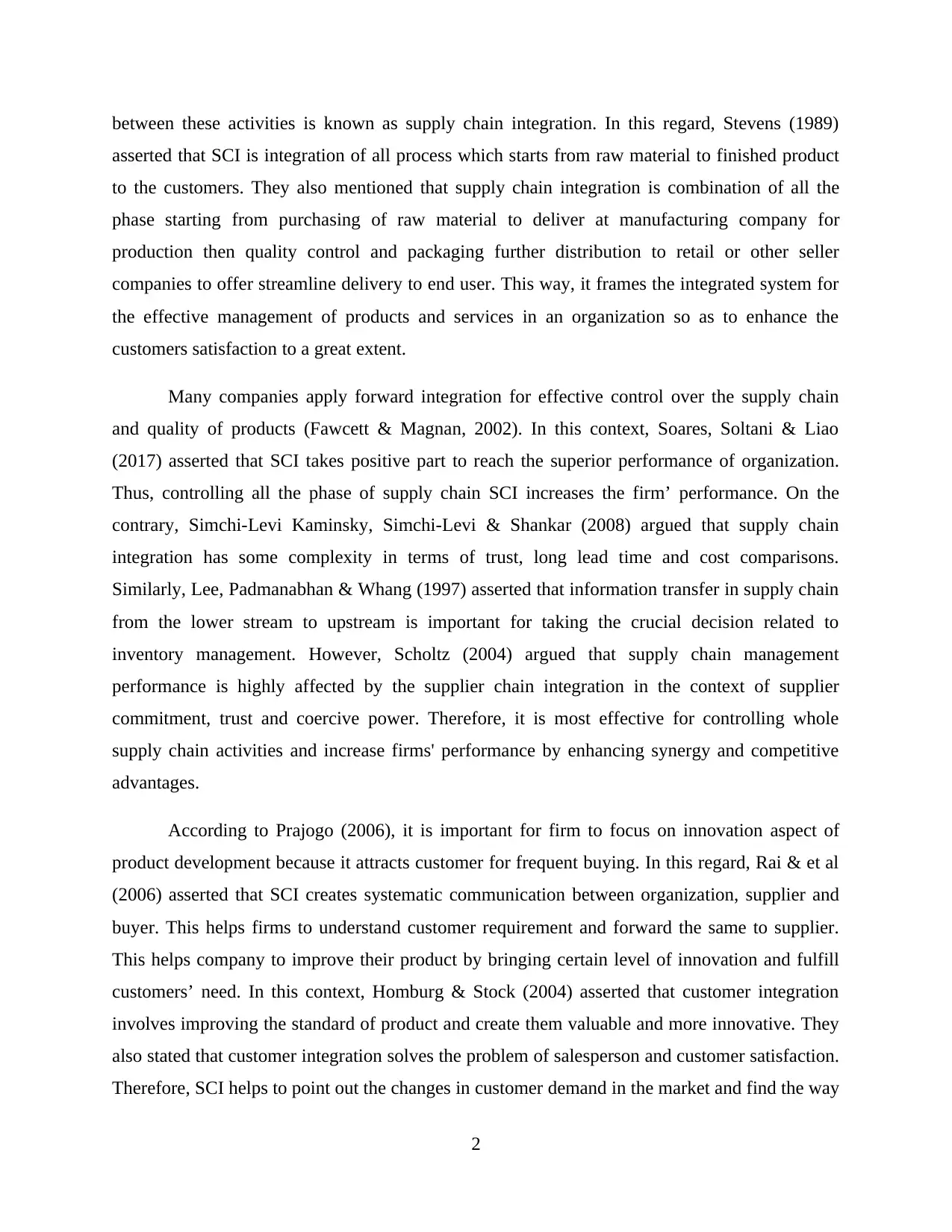
between these activities is known as supply chain integration. In this regard, Stevens (1989)
asserted that SCI is integration of all process which starts from raw material to finished product
to the customers. They also mentioned that supply chain integration is combination of all the
phase starting from purchasing of raw material to deliver at manufacturing company for
production then quality control and packaging further distribution to retail or other seller
companies to offer streamline delivery to end user. This way, it frames the integrated system for
the effective management of products and services in an organization so as to enhance the
customers satisfaction to a great extent.
Many companies apply forward integration for effective control over the supply chain
and quality of products (Fawcett & Magnan, 2002). In this context, Soares, Soltani & Liao
(2017) asserted that SCI takes positive part to reach the superior performance of organization.
Thus, controlling all the phase of supply chain SCI increases the firm’ performance. On the
contrary, Simchi-Levi Kaminsky, Simchi-Levi & Shankar (2008) argued that supply chain
integration has some complexity in terms of trust, long lead time and cost comparisons.
Similarly, Lee, Padmanabhan & Whang (1997) asserted that information transfer in supply chain
from the lower stream to upstream is important for taking the crucial decision related to
inventory management. However, Scholtz (2004) argued that supply chain management
performance is highly affected by the supplier chain integration in the context of supplier
commitment, trust and coercive power. Therefore, it is most effective for controlling whole
supply chain activities and increase firms' performance by enhancing synergy and competitive
advantages.
According to Prajogo (2006), it is important for firm to focus on innovation aspect of
product development because it attracts customer for frequent buying. In this regard, Rai & et al
(2006) asserted that SCI creates systematic communication between organization, supplier and
buyer. This helps firms to understand customer requirement and forward the same to supplier.
This helps company to improve their product by bringing certain level of innovation and fulfill
customers’ need. In this context, Homburg & Stock (2004) asserted that customer integration
involves improving the standard of product and create them valuable and more innovative. They
also stated that customer integration solves the problem of salesperson and customer satisfaction.
Therefore, SCI helps to point out the changes in customer demand in the market and find the way
2
asserted that SCI is integration of all process which starts from raw material to finished product
to the customers. They also mentioned that supply chain integration is combination of all the
phase starting from purchasing of raw material to deliver at manufacturing company for
production then quality control and packaging further distribution to retail or other seller
companies to offer streamline delivery to end user. This way, it frames the integrated system for
the effective management of products and services in an organization so as to enhance the
customers satisfaction to a great extent.
Many companies apply forward integration for effective control over the supply chain
and quality of products (Fawcett & Magnan, 2002). In this context, Soares, Soltani & Liao
(2017) asserted that SCI takes positive part to reach the superior performance of organization.
Thus, controlling all the phase of supply chain SCI increases the firm’ performance. On the
contrary, Simchi-Levi Kaminsky, Simchi-Levi & Shankar (2008) argued that supply chain
integration has some complexity in terms of trust, long lead time and cost comparisons.
Similarly, Lee, Padmanabhan & Whang (1997) asserted that information transfer in supply chain
from the lower stream to upstream is important for taking the crucial decision related to
inventory management. However, Scholtz (2004) argued that supply chain management
performance is highly affected by the supplier chain integration in the context of supplier
commitment, trust and coercive power. Therefore, it is most effective for controlling whole
supply chain activities and increase firms' performance by enhancing synergy and competitive
advantages.
According to Prajogo (2006), it is important for firm to focus on innovation aspect of
product development because it attracts customer for frequent buying. In this regard, Rai & et al
(2006) asserted that SCI creates systematic communication between organization, supplier and
buyer. This helps firms to understand customer requirement and forward the same to supplier.
This helps company to improve their product by bringing certain level of innovation and fulfill
customers’ need. In this context, Homburg & Stock (2004) asserted that customer integration
involves improving the standard of product and create them valuable and more innovative. They
also stated that customer integration solves the problem of salesperson and customer satisfaction.
Therefore, SCI helps to point out the changes in customer demand in the market and find the way
2
⊘ This is a preview!⊘
Do you want full access?
Subscribe today to unlock all pages.

Trusted by 1+ million students worldwide
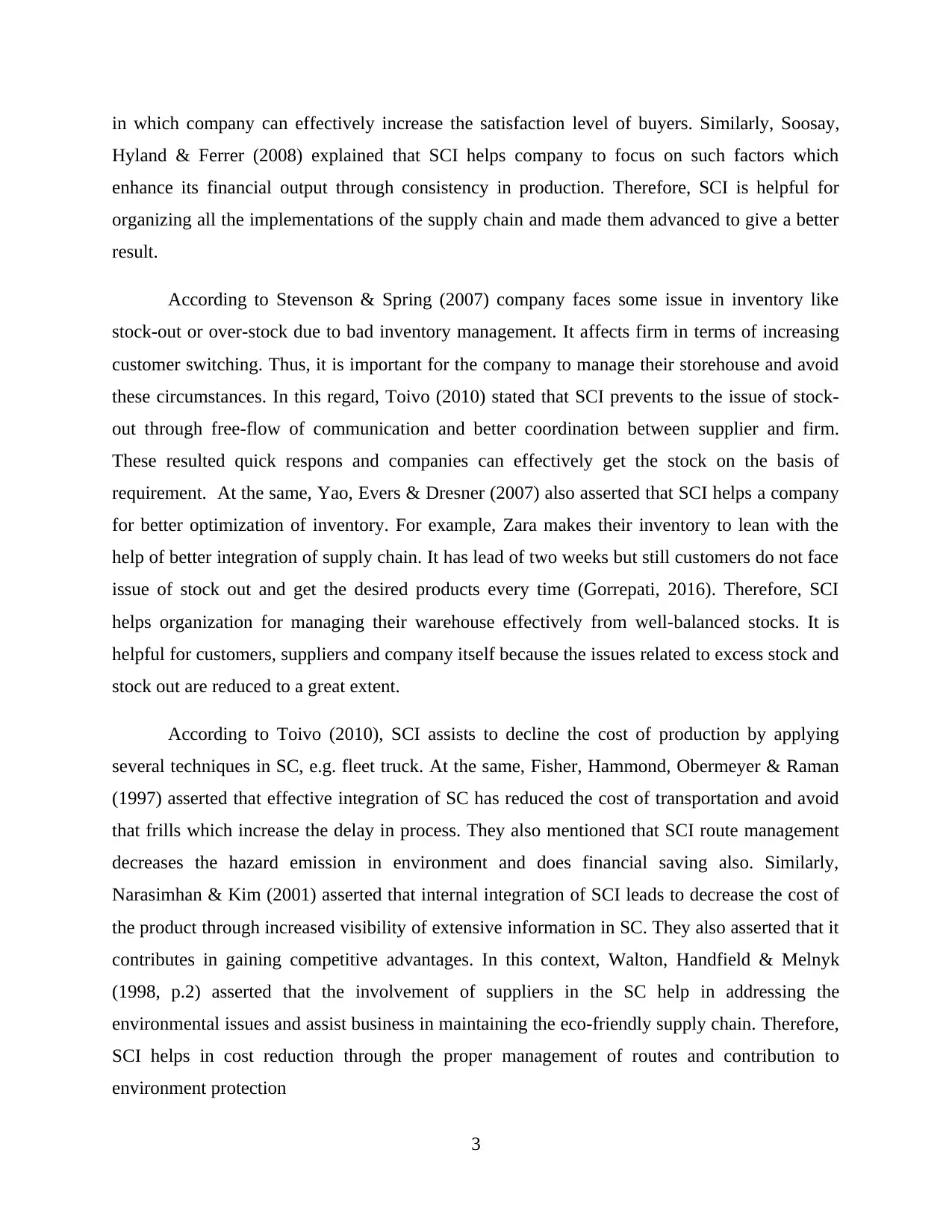
in which company can effectively increase the satisfaction level of buyers. Similarly, Soosay,
Hyland & Ferrer (2008) explained that SCI helps company to focus on such factors which
enhance its financial output through consistency in production. Therefore, SCI is helpful for
organizing all the implementations of the supply chain and made them advanced to give a better
result.
According to Stevenson & Spring (2007) company faces some issue in inventory like
stock-out or over-stock due to bad inventory management. It affects firm in terms of increasing
customer switching. Thus, it is important for the company to manage their storehouse and avoid
these circumstances. In this regard, Toivo (2010) stated that SCI prevents to the issue of stock-
out through free-flow of communication and better coordination between supplier and firm.
These resulted quick respons and companies can effectively get the stock on the basis of
requirement. At the same, Yao, Evers & Dresner (2007) also asserted that SCI helps a company
for better optimization of inventory. For example, Zara makes their inventory to lean with the
help of better integration of supply chain. It has lead of two weeks but still customers do not face
issue of stock out and get the desired products every time (Gorrepati, 2016). Therefore, SCI
helps organization for managing their warehouse effectively from well-balanced stocks. It is
helpful for customers, suppliers and company itself because the issues related to excess stock and
stock out are reduced to a great extent.
According to Toivo (2010), SCI assists to decline the cost of production by applying
several techniques in SC, e.g. fleet truck. At the same, Fisher, Hammond, Obermeyer & Raman
(1997) asserted that effective integration of SC has reduced the cost of transportation and avoid
that frills which increase the delay in process. They also mentioned that SCI route management
decreases the hazard emission in environment and does financial saving also. Similarly,
Narasimhan & Kim (2001) asserted that internal integration of SCI leads to decrease the cost of
the product through increased visibility of extensive information in SC. They also asserted that it
contributes in gaining competitive advantages. In this context, Walton, Handfield & Melnyk
(1998, p.2) asserted that the involvement of suppliers in the SC help in addressing the
environmental issues and assist business in maintaining the eco-friendly supply chain. Therefore,
SCI helps in cost reduction through the proper management of routes and contribution to
environment protection
3
Hyland & Ferrer (2008) explained that SCI helps company to focus on such factors which
enhance its financial output through consistency in production. Therefore, SCI is helpful for
organizing all the implementations of the supply chain and made them advanced to give a better
result.
According to Stevenson & Spring (2007) company faces some issue in inventory like
stock-out or over-stock due to bad inventory management. It affects firm in terms of increasing
customer switching. Thus, it is important for the company to manage their storehouse and avoid
these circumstances. In this regard, Toivo (2010) stated that SCI prevents to the issue of stock-
out through free-flow of communication and better coordination between supplier and firm.
These resulted quick respons and companies can effectively get the stock on the basis of
requirement. At the same, Yao, Evers & Dresner (2007) also asserted that SCI helps a company
for better optimization of inventory. For example, Zara makes their inventory to lean with the
help of better integration of supply chain. It has lead of two weeks but still customers do not face
issue of stock out and get the desired products every time (Gorrepati, 2016). Therefore, SCI
helps organization for managing their warehouse effectively from well-balanced stocks. It is
helpful for customers, suppliers and company itself because the issues related to excess stock and
stock out are reduced to a great extent.
According to Toivo (2010), SCI assists to decline the cost of production by applying
several techniques in SC, e.g. fleet truck. At the same, Fisher, Hammond, Obermeyer & Raman
(1997) asserted that effective integration of SC has reduced the cost of transportation and avoid
that frills which increase the delay in process. They also mentioned that SCI route management
decreases the hazard emission in environment and does financial saving also. Similarly,
Narasimhan & Kim (2001) asserted that internal integration of SCI leads to decrease the cost of
the product through increased visibility of extensive information in SC. They also asserted that it
contributes in gaining competitive advantages. In this context, Walton, Handfield & Melnyk
(1998, p.2) asserted that the involvement of suppliers in the SC help in addressing the
environmental issues and assist business in maintaining the eco-friendly supply chain. Therefore,
SCI helps in cost reduction through the proper management of routes and contribution to
environment protection
3
Paraphrase This Document
Need a fresh take? Get an instant paraphrase of this document with our AI Paraphraser
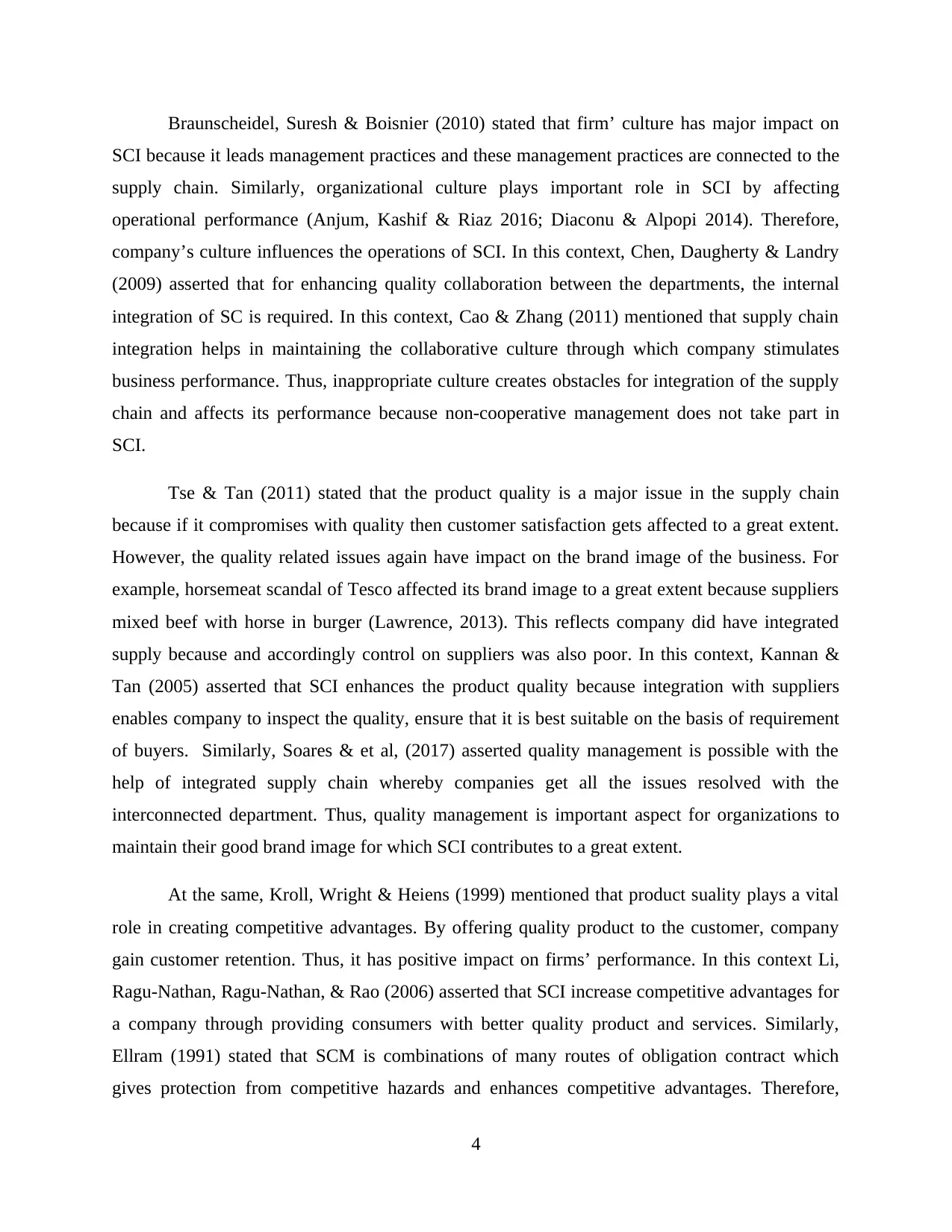
Braunscheidel, Suresh & Boisnier (2010) stated that firm’ culture has major impact on
SCI because it leads management practices and these management practices are connected to the
supply chain. Similarly, organizational culture plays important role in SCI by affecting
operational performance (Anjum, Kashif & Riaz 2016; Diaconu & Alpopi 2014). Therefore,
company’s culture influences the operations of SCI. In this context, Chen, Daugherty & Landry
(2009) asserted that for enhancing quality collaboration between the departments, the internal
integration of SC is required. In this context, Cao & Zhang (2011) mentioned that supply chain
integration helps in maintaining the collaborative culture through which company stimulates
business performance. Thus, inappropriate culture creates obstacles for integration of the supply
chain and affects its performance because non-cooperative management does not take part in
SCI.
Tse & Tan (2011) stated that the product quality is a major issue in the supply chain
because if it compromises with quality then customer satisfaction gets affected to a great extent.
However, the quality related issues again have impact on the brand image of the business. For
example, horsemeat scandal of Tesco affected its brand image to a great extent because suppliers
mixed beef with horse in burger (Lawrence, 2013). This reflects company did have integrated
supply because and accordingly control on suppliers was also poor. In this context, Kannan &
Tan (2005) asserted that SCI enhances the product quality because integration with suppliers
enables company to inspect the quality, ensure that it is best suitable on the basis of requirement
of buyers. Similarly, Soares & et al, (2017) asserted quality management is possible with the
help of integrated supply chain whereby companies get all the issues resolved with the
interconnected department. Thus, quality management is important aspect for organizations to
maintain their good brand image for which SCI contributes to a great extent.
At the same, Kroll, Wright & Heiens (1999) mentioned that product suality plays a vital
role in creating competitive advantages. By offering quality product to the customer, company
gain customer retention. Thus, it has positive impact on firms’ performance. In this context Li,
Ragu-Nathan, Ragu-Nathan, & Rao (2006) asserted that SCI increase competitive advantages for
a company through providing consumers with better quality product and services. Similarly,
Ellram (1991) stated that SCM is combinations of many routes of obligation contract which
gives protection from competitive hazards and enhances competitive advantages. Therefore,
4
SCI because it leads management practices and these management practices are connected to the
supply chain. Similarly, organizational culture plays important role in SCI by affecting
operational performance (Anjum, Kashif & Riaz 2016; Diaconu & Alpopi 2014). Therefore,
company’s culture influences the operations of SCI. In this context, Chen, Daugherty & Landry
(2009) asserted that for enhancing quality collaboration between the departments, the internal
integration of SC is required. In this context, Cao & Zhang (2011) mentioned that supply chain
integration helps in maintaining the collaborative culture through which company stimulates
business performance. Thus, inappropriate culture creates obstacles for integration of the supply
chain and affects its performance because non-cooperative management does not take part in
SCI.
Tse & Tan (2011) stated that the product quality is a major issue in the supply chain
because if it compromises with quality then customer satisfaction gets affected to a great extent.
However, the quality related issues again have impact on the brand image of the business. For
example, horsemeat scandal of Tesco affected its brand image to a great extent because suppliers
mixed beef with horse in burger (Lawrence, 2013). This reflects company did have integrated
supply because and accordingly control on suppliers was also poor. In this context, Kannan &
Tan (2005) asserted that SCI enhances the product quality because integration with suppliers
enables company to inspect the quality, ensure that it is best suitable on the basis of requirement
of buyers. Similarly, Soares & et al, (2017) asserted quality management is possible with the
help of integrated supply chain whereby companies get all the issues resolved with the
interconnected department. Thus, quality management is important aspect for organizations to
maintain their good brand image for which SCI contributes to a great extent.
At the same, Kroll, Wright & Heiens (1999) mentioned that product suality plays a vital
role in creating competitive advantages. By offering quality product to the customer, company
gain customer retention. Thus, it has positive impact on firms’ performance. In this context Li,
Ragu-Nathan, Ragu-Nathan, & Rao (2006) asserted that SCI increase competitive advantages for
a company through providing consumers with better quality product and services. Similarly,
Ellram (1991) stated that SCM is combinations of many routes of obligation contract which
gives protection from competitive hazards and enhances competitive advantages. Therefore,
4
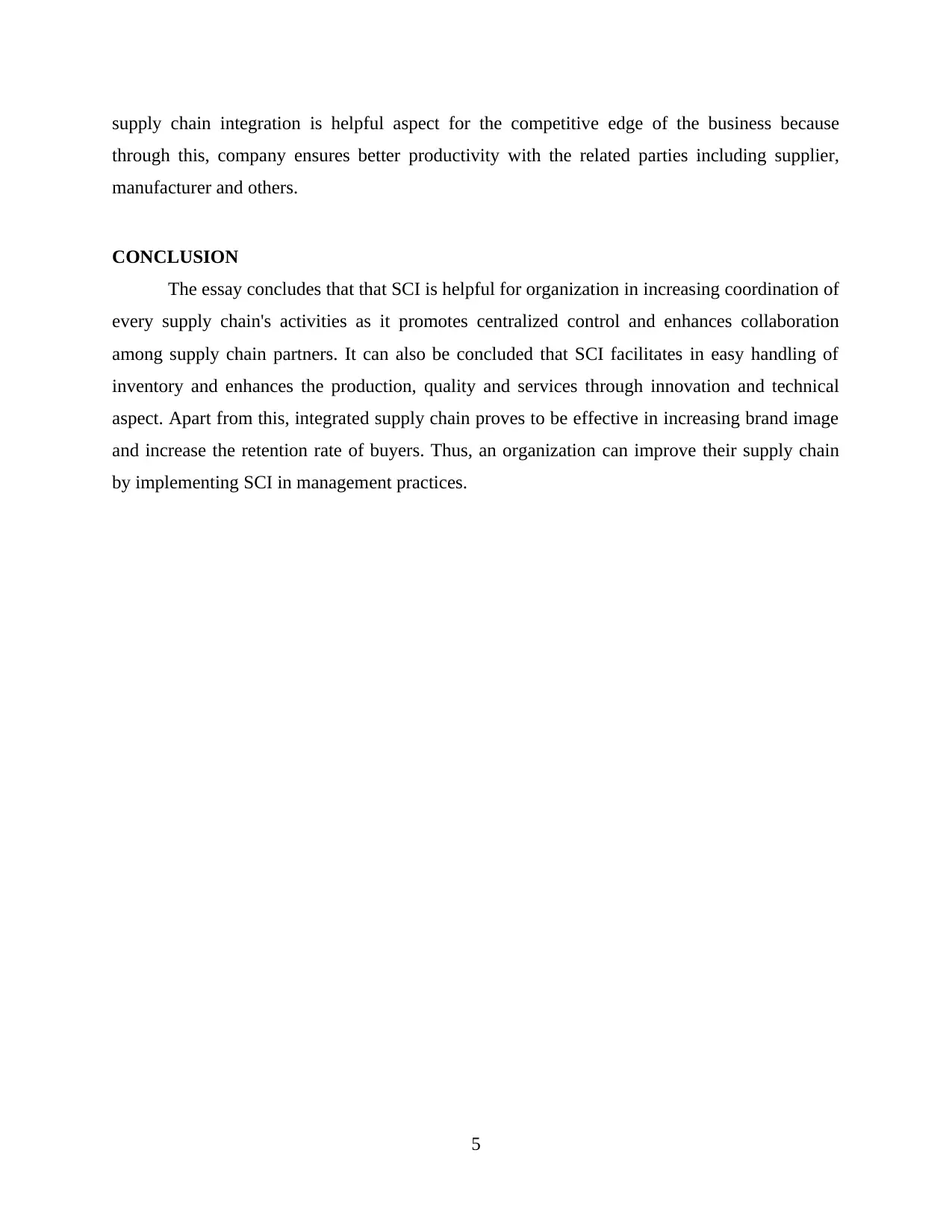
supply chain integration is helpful aspect for the competitive edge of the business because
through this, company ensures better productivity with the related parties including supplier,
manufacturer and others.
CONCLUSION
The essay concludes that that SCI is helpful for organization in increasing coordination of
every supply chain's activities as it promotes centralized control and enhances collaboration
among supply chain partners. It can also be concluded that SCI facilitates in easy handling of
inventory and enhances the production, quality and services through innovation and technical
aspect. Apart from this, integrated supply chain proves to be effective in increasing brand image
and increase the retention rate of buyers. Thus, an organization can improve their supply chain
by implementing SCI in management practices.
5
through this, company ensures better productivity with the related parties including supplier,
manufacturer and others.
CONCLUSION
The essay concludes that that SCI is helpful for organization in increasing coordination of
every supply chain's activities as it promotes centralized control and enhances collaboration
among supply chain partners. It can also be concluded that SCI facilitates in easy handling of
inventory and enhances the production, quality and services through innovation and technical
aspect. Apart from this, integrated supply chain proves to be effective in increasing brand image
and increase the retention rate of buyers. Thus, an organization can improve their supply chain
by implementing SCI in management practices.
5
⊘ This is a preview!⊘
Do you want full access?
Subscribe today to unlock all pages.

Trusted by 1+ million students worldwide
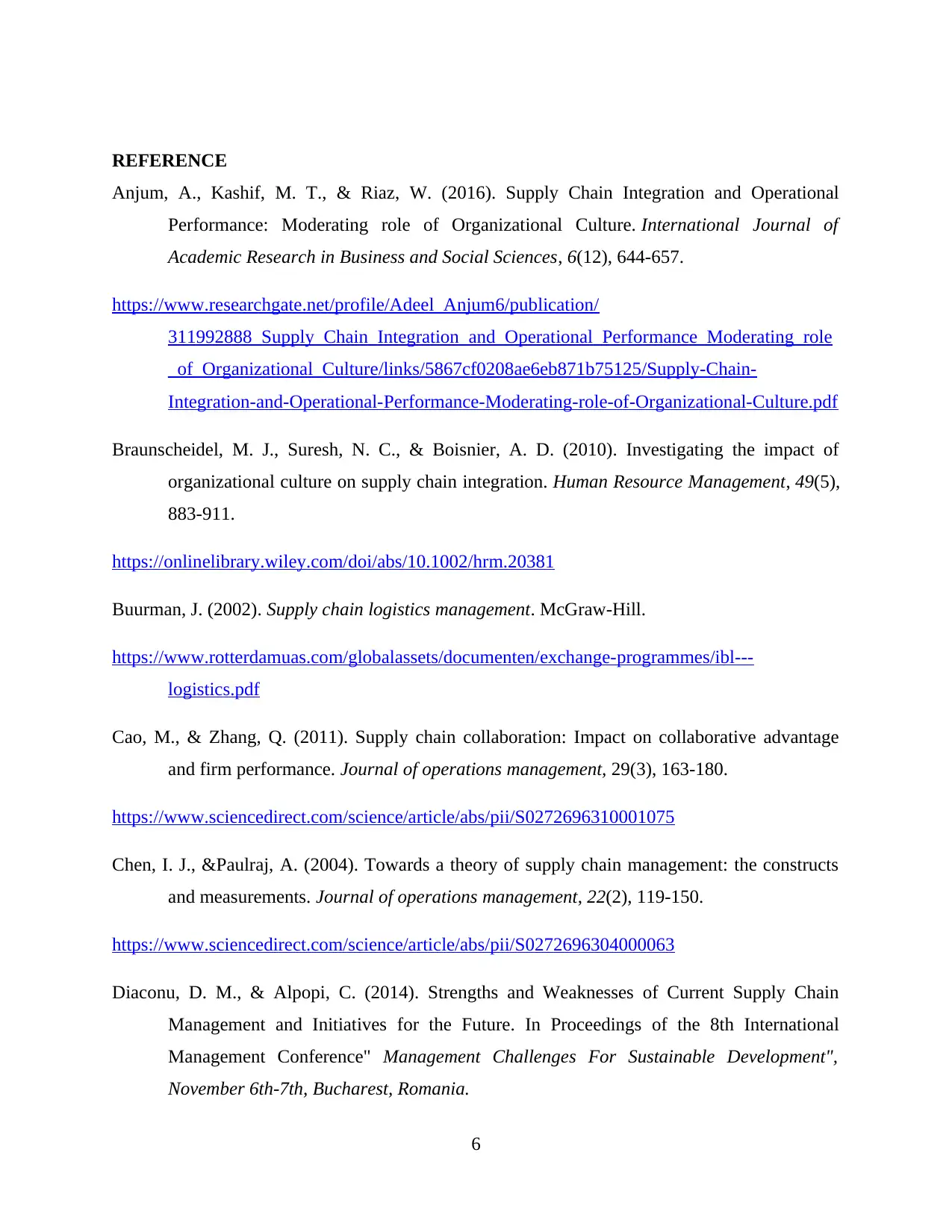
REFERENCE
Anjum, A., Kashif, M. T., & Riaz, W. (2016). Supply Chain Integration and Operational
Performance: Moderating role of Organizational Culture. International Journal of
Academic Research in Business and Social Sciences, 6(12), 644-657.
https://www.researchgate.net/profile/Adeel_Anjum6/publication/
311992888_Supply_Chain_Integration_and_Operational_Performance_Moderating_role
_of_Organizational_Culture/links/5867cf0208ae6eb871b75125/Supply-Chain-
Integration-and-Operational-Performance-Moderating-role-of-Organizational-Culture.pdf
Braunscheidel, M. J., Suresh, N. C., & Boisnier, A. D. (2010). Investigating the impact of
organizational culture on supply chain integration. Human Resource Management, 49(5),
883-911.
https://onlinelibrary.wiley.com/doi/abs/10.1002/hrm.20381
Buurman, J. (2002). Supply chain logistics management. McGraw-Hill.
https://www.rotterdamuas.com/globalassets/documenten/exchange-programmes/ibl---
logistics.pdf
Cao, M., & Zhang, Q. (2011). Supply chain collaboration: Impact on collaborative advantage
and firm performance. Journal of operations management, 29(3), 163-180.
https://www.sciencedirect.com/science/article/abs/pii/S0272696310001075
Chen, I. J., &Paulraj, A. (2004). Towards a theory of supply chain management: the constructs
and measurements. Journal of operations management, 22(2), 119-150.
https://www.sciencedirect.com/science/article/abs/pii/S0272696304000063
Diaconu, D. M., & Alpopi, C. (2014). Strengths and Weaknesses of Current Supply Chain
Management and Initiatives for the Future. In Proceedings of the 8th International
Management Conference" Management Challenges For Sustainable Development",
November 6th-7th, Bucharest, Romania.
6
Anjum, A., Kashif, M. T., & Riaz, W. (2016). Supply Chain Integration and Operational
Performance: Moderating role of Organizational Culture. International Journal of
Academic Research in Business and Social Sciences, 6(12), 644-657.
https://www.researchgate.net/profile/Adeel_Anjum6/publication/
311992888_Supply_Chain_Integration_and_Operational_Performance_Moderating_role
_of_Organizational_Culture/links/5867cf0208ae6eb871b75125/Supply-Chain-
Integration-and-Operational-Performance-Moderating-role-of-Organizational-Culture.pdf
Braunscheidel, M. J., Suresh, N. C., & Boisnier, A. D. (2010). Investigating the impact of
organizational culture on supply chain integration. Human Resource Management, 49(5),
883-911.
https://onlinelibrary.wiley.com/doi/abs/10.1002/hrm.20381
Buurman, J. (2002). Supply chain logistics management. McGraw-Hill.
https://www.rotterdamuas.com/globalassets/documenten/exchange-programmes/ibl---
logistics.pdf
Cao, M., & Zhang, Q. (2011). Supply chain collaboration: Impact on collaborative advantage
and firm performance. Journal of operations management, 29(3), 163-180.
https://www.sciencedirect.com/science/article/abs/pii/S0272696310001075
Chen, I. J., &Paulraj, A. (2004). Towards a theory of supply chain management: the constructs
and measurements. Journal of operations management, 22(2), 119-150.
https://www.sciencedirect.com/science/article/abs/pii/S0272696304000063
Diaconu, D. M., & Alpopi, C. (2014). Strengths and Weaknesses of Current Supply Chain
Management and Initiatives for the Future. In Proceedings of the 8th International
Management Conference" Management Challenges For Sustainable Development",
November 6th-7th, Bucharest, Romania.
6
Paraphrase This Document
Need a fresh take? Get an instant paraphrase of this document with our AI Paraphraser
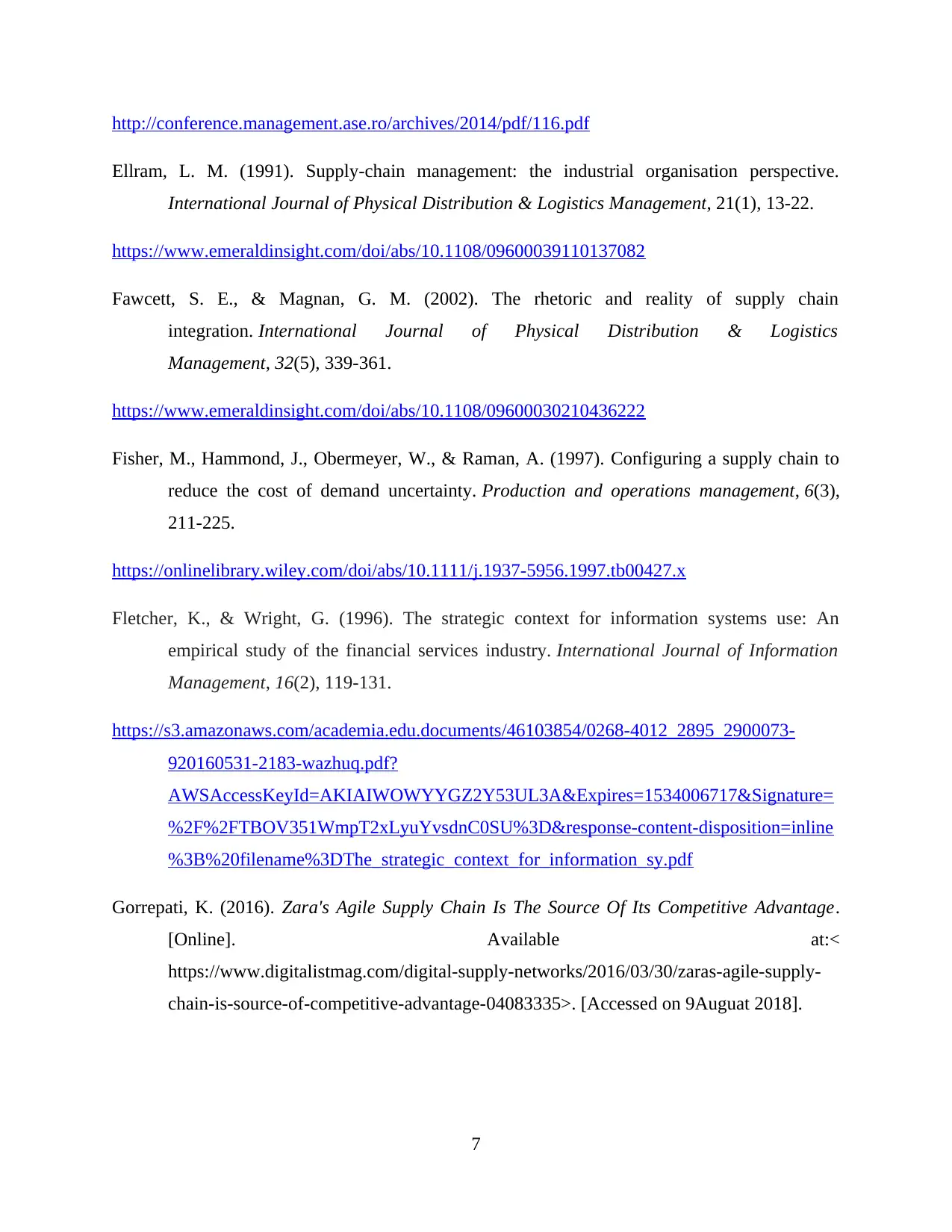
http://conference.management.ase.ro/archives/2014/pdf/116.pdf
Ellram, L. M. (1991). Supply-chain management: the industrial organisation perspective.
International Journal of Physical Distribution & Logistics Management, 21(1), 13-22.
https://www.emeraldinsight.com/doi/abs/10.1108/09600039110137082
Fawcett, S. E., & Magnan, G. M. (2002). The rhetoric and reality of supply chain
integration. International Journal of Physical Distribution & Logistics
Management, 32(5), 339-361.
https://www.emeraldinsight.com/doi/abs/10.1108/09600030210436222
Fisher, M., Hammond, J., Obermeyer, W., & Raman, A. (1997). Configuring a supply chain to
reduce the cost of demand uncertainty. Production and operations management, 6(3),
211-225.
https://onlinelibrary.wiley.com/doi/abs/10.1111/j.1937-5956.1997.tb00427.x
Fletcher, K., & Wright, G. (1996). The strategic context for information systems use: An
empirical study of the financial services industry. International Journal of Information
Management, 16(2), 119-131.
https://s3.amazonaws.com/academia.edu.documents/46103854/0268-4012_2895_2900073-
920160531-2183-wazhuq.pdf?
AWSAccessKeyId=AKIAIWOWYYGZ2Y53UL3A&Expires=1534006717&Signature=
%2F%2FTBOV351WmpT2xLyuYvsdnC0SU%3D&response-content-disposition=inline
%3B%20filename%3DThe_strategic_context_for_information_sy.pdf
Gorrepati, K. (2016). Zara's Agile Supply Chain Is The Source Of Its Competitive Advantage.
[Online]. Available at:<
https://www.digitalistmag.com/digital-supply-networks/2016/03/30/zaras-agile-supply-
chain-is-source-of-competitive-advantage-04083335>. [Accessed on 9Auguat 2018].
7
Ellram, L. M. (1991). Supply-chain management: the industrial organisation perspective.
International Journal of Physical Distribution & Logistics Management, 21(1), 13-22.
https://www.emeraldinsight.com/doi/abs/10.1108/09600039110137082
Fawcett, S. E., & Magnan, G. M. (2002). The rhetoric and reality of supply chain
integration. International Journal of Physical Distribution & Logistics
Management, 32(5), 339-361.
https://www.emeraldinsight.com/doi/abs/10.1108/09600030210436222
Fisher, M., Hammond, J., Obermeyer, W., & Raman, A. (1997). Configuring a supply chain to
reduce the cost of demand uncertainty. Production and operations management, 6(3),
211-225.
https://onlinelibrary.wiley.com/doi/abs/10.1111/j.1937-5956.1997.tb00427.x
Fletcher, K., & Wright, G. (1996). The strategic context for information systems use: An
empirical study of the financial services industry. International Journal of Information
Management, 16(2), 119-131.
https://s3.amazonaws.com/academia.edu.documents/46103854/0268-4012_2895_2900073-
920160531-2183-wazhuq.pdf?
AWSAccessKeyId=AKIAIWOWYYGZ2Y53UL3A&Expires=1534006717&Signature=
%2F%2FTBOV351WmpT2xLyuYvsdnC0SU%3D&response-content-disposition=inline
%3B%20filename%3DThe_strategic_context_for_information_sy.pdf
Gorrepati, K. (2016). Zara's Agile Supply Chain Is The Source Of Its Competitive Advantage.
[Online]. Available at:<
https://www.digitalistmag.com/digital-supply-networks/2016/03/30/zaras-agile-supply-
chain-is-source-of-competitive-advantage-04083335>. [Accessed on 9Auguat 2018].
7
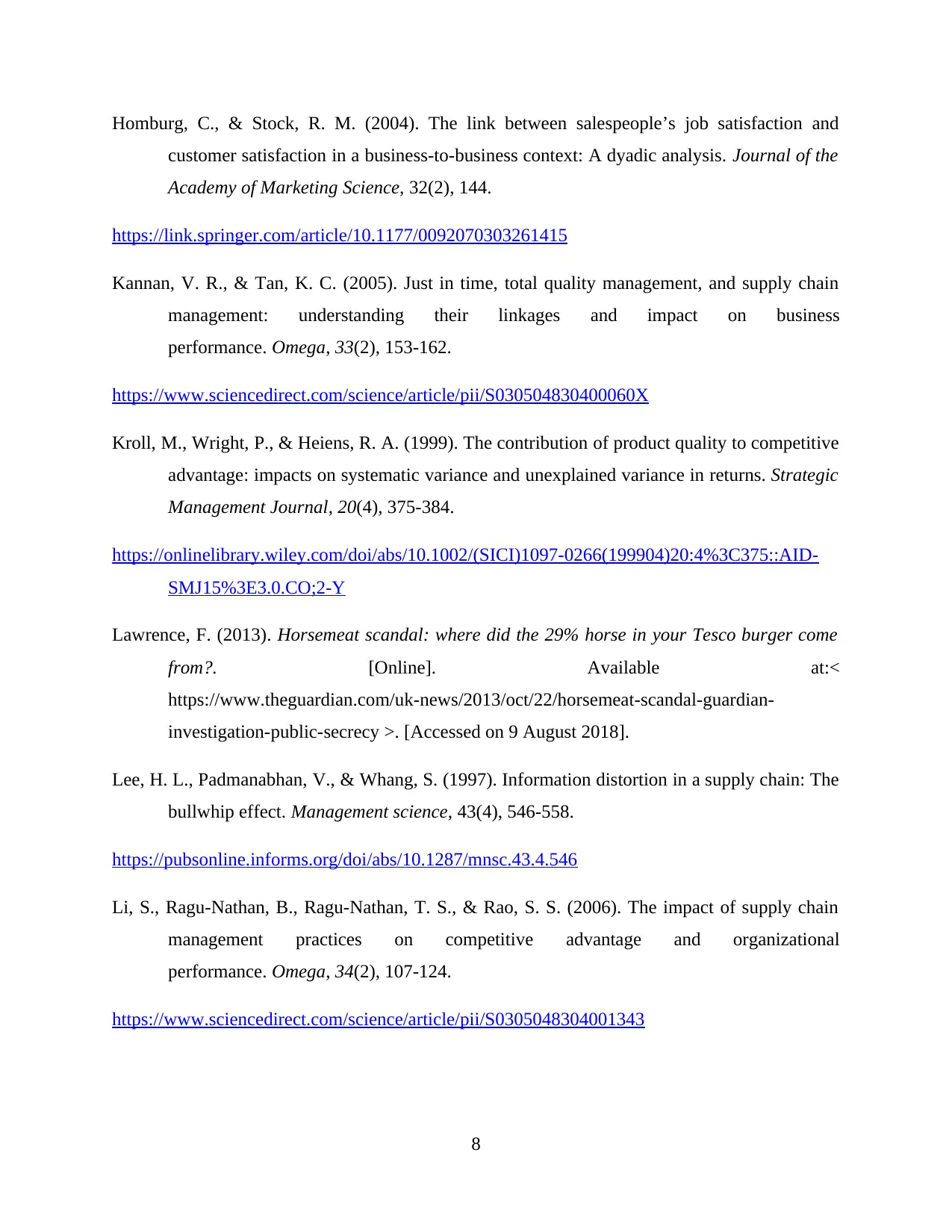
Homburg, C., & Stock, R. M. (2004). The link between salespeople’s job satisfaction and
customer satisfaction in a business-to-business context: A dyadic analysis. Journal of the
Academy of Marketing Science, 32(2), 144.
https://link.springer.com/article/10.1177/0092070303261415
Kannan, V. R., & Tan, K. C. (2005). Just in time, total quality management, and supply chain
management: understanding their linkages and impact on business
performance. Omega, 33(2), 153-162.
https://www.sciencedirect.com/science/article/pii/S030504830400060X
Kroll, M., Wright, P., & Heiens, R. A. (1999). The contribution of product quality to competitive
advantage: impacts on systematic variance and unexplained variance in returns. Strategic
Management Journal, 20(4), 375-384.
https://onlinelibrary.wiley.com/doi/abs/10.1002/(SICI)1097-0266(199904)20:4%3C375::AID-
SMJ15%3E3.0.CO;2-Y
Lawrence, F. (2013). Horsemeat scandal: where did the 29% horse in your Tesco burger come
from?. [Online]. Available at:<
https://www.theguardian.com/uk-news/2013/oct/22/horsemeat-scandal-guardian-
investigation-public-secrecy >. [Accessed on 9 August 2018].
Lee, H. L., Padmanabhan, V., & Whang, S. (1997). Information distortion in a supply chain: The
bullwhip effect. Management science, 43(4), 546-558.
https://pubsonline.informs.org/doi/abs/10.1287/mnsc.43.4.546
Li, S., Ragu-Nathan, B., Ragu-Nathan, T. S., & Rao, S. S. (2006). The impact of supply chain
management practices on competitive advantage and organizational
performance. Omega, 34(2), 107-124.
https://www.sciencedirect.com/science/article/pii/S0305048304001343
8
customer satisfaction in a business-to-business context: A dyadic analysis. Journal of the
Academy of Marketing Science, 32(2), 144.
https://link.springer.com/article/10.1177/0092070303261415
Kannan, V. R., & Tan, K. C. (2005). Just in time, total quality management, and supply chain
management: understanding their linkages and impact on business
performance. Omega, 33(2), 153-162.
https://www.sciencedirect.com/science/article/pii/S030504830400060X
Kroll, M., Wright, P., & Heiens, R. A. (1999). The contribution of product quality to competitive
advantage: impacts on systematic variance and unexplained variance in returns. Strategic
Management Journal, 20(4), 375-384.
https://onlinelibrary.wiley.com/doi/abs/10.1002/(SICI)1097-0266(199904)20:4%3C375::AID-
SMJ15%3E3.0.CO;2-Y
Lawrence, F. (2013). Horsemeat scandal: where did the 29% horse in your Tesco burger come
from?. [Online]. Available at:<
https://www.theguardian.com/uk-news/2013/oct/22/horsemeat-scandal-guardian-
investigation-public-secrecy >. [Accessed on 9 August 2018].
Lee, H. L., Padmanabhan, V., & Whang, S. (1997). Information distortion in a supply chain: The
bullwhip effect. Management science, 43(4), 546-558.
https://pubsonline.informs.org/doi/abs/10.1287/mnsc.43.4.546
Li, S., Ragu-Nathan, B., Ragu-Nathan, T. S., & Rao, S. S. (2006). The impact of supply chain
management practices on competitive advantage and organizational
performance. Omega, 34(2), 107-124.
https://www.sciencedirect.com/science/article/pii/S0305048304001343
8
⊘ This is a preview!⊘
Do you want full access?
Subscribe today to unlock all pages.

Trusted by 1+ million students worldwide
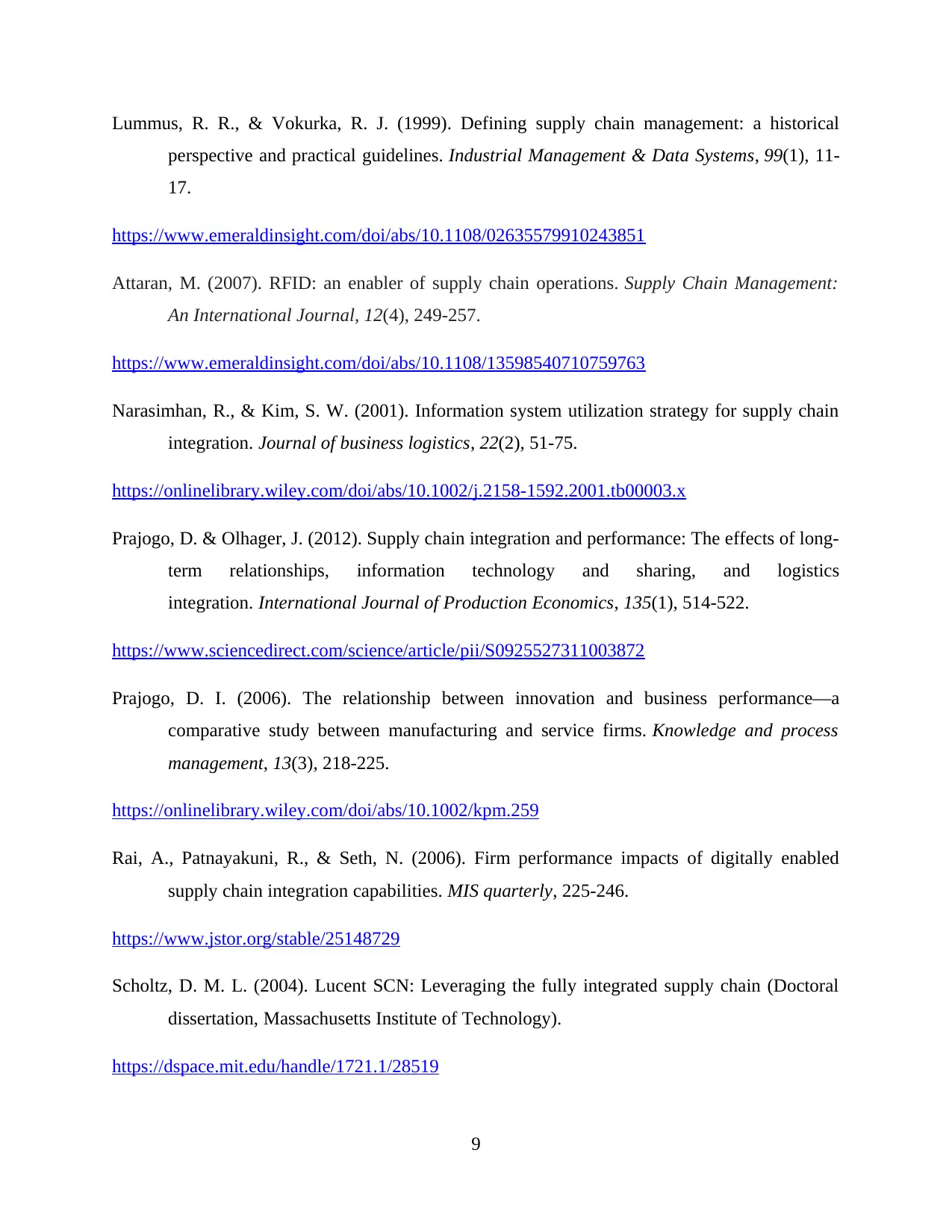
Lummus, R. R., & Vokurka, R. J. (1999). Defining supply chain management: a historical
perspective and practical guidelines. Industrial Management & Data Systems, 99(1), 11-
17.
https://www.emeraldinsight.com/doi/abs/10.1108/02635579910243851
Attaran, M. (2007). RFID: an enabler of supply chain operations. Supply Chain Management:
An International Journal, 12(4), 249-257.
https://www.emeraldinsight.com/doi/abs/10.1108/13598540710759763
Narasimhan, R., & Kim, S. W. (2001). Information system utilization strategy for supply chain
integration. Journal of business logistics, 22(2), 51-75.
https://onlinelibrary.wiley.com/doi/abs/10.1002/j.2158-1592.2001.tb00003.x
Prajogo, D. & Olhager, J. (2012). Supply chain integration and performance: The effects of long-
term relationships, information technology and sharing, and logistics
integration. International Journal of Production Economics, 135(1), 514-522.
https://www.sciencedirect.com/science/article/pii/S0925527311003872
Prajogo, D. I. (2006). The relationship between innovation and business performance—a
comparative study between manufacturing and service firms. Knowledge and process
management, 13(3), 218-225.
https://onlinelibrary.wiley.com/doi/abs/10.1002/kpm.259
Rai, A., Patnayakuni, R., & Seth, N. (2006). Firm performance impacts of digitally enabled
supply chain integration capabilities. MIS quarterly, 225-246.
https://www.jstor.org/stable/25148729
Scholtz, D. M. L. (2004). Lucent SCN: Leveraging the fully integrated supply chain (Doctoral
dissertation, Massachusetts Institute of Technology).
https://dspace.mit.edu/handle/1721.1/28519
9
perspective and practical guidelines. Industrial Management & Data Systems, 99(1), 11-
17.
https://www.emeraldinsight.com/doi/abs/10.1108/02635579910243851
Attaran, M. (2007). RFID: an enabler of supply chain operations. Supply Chain Management:
An International Journal, 12(4), 249-257.
https://www.emeraldinsight.com/doi/abs/10.1108/13598540710759763
Narasimhan, R., & Kim, S. W. (2001). Information system utilization strategy for supply chain
integration. Journal of business logistics, 22(2), 51-75.
https://onlinelibrary.wiley.com/doi/abs/10.1002/j.2158-1592.2001.tb00003.x
Prajogo, D. & Olhager, J. (2012). Supply chain integration and performance: The effects of long-
term relationships, information technology and sharing, and logistics
integration. International Journal of Production Economics, 135(1), 514-522.
https://www.sciencedirect.com/science/article/pii/S0925527311003872
Prajogo, D. I. (2006). The relationship between innovation and business performance—a
comparative study between manufacturing and service firms. Knowledge and process
management, 13(3), 218-225.
https://onlinelibrary.wiley.com/doi/abs/10.1002/kpm.259
Rai, A., Patnayakuni, R., & Seth, N. (2006). Firm performance impacts of digitally enabled
supply chain integration capabilities. MIS quarterly, 225-246.
https://www.jstor.org/stable/25148729
Scholtz, D. M. L. (2004). Lucent SCN: Leveraging the fully integrated supply chain (Doctoral
dissertation, Massachusetts Institute of Technology).
https://dspace.mit.edu/handle/1721.1/28519
9
Paraphrase This Document
Need a fresh take? Get an instant paraphrase of this document with our AI Paraphraser
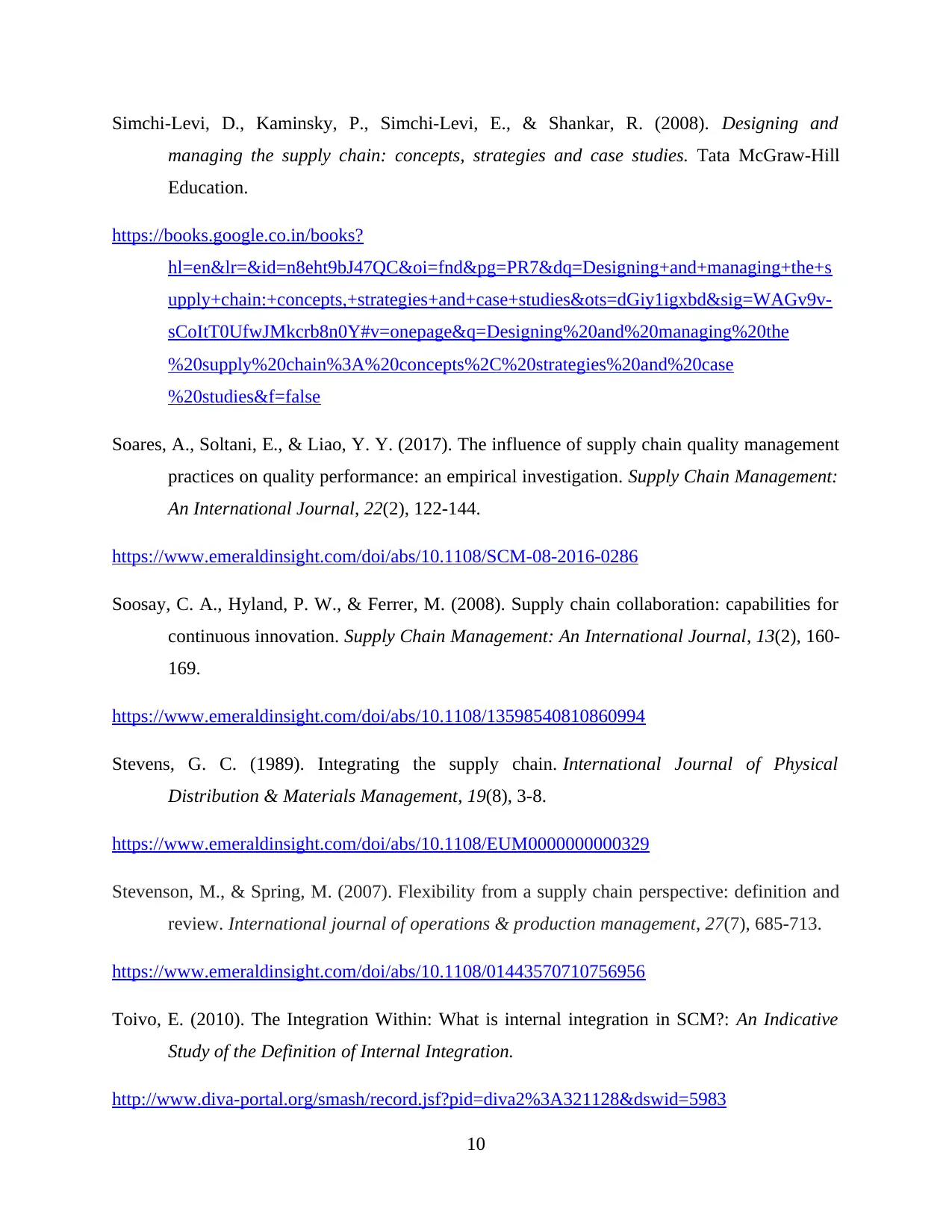
Simchi-Levi, D., Kaminsky, P., Simchi-Levi, E., & Shankar, R. (2008). Designing and
managing the supply chain: concepts, strategies and case studies. Tata McGraw-Hill
Education.
https://books.google.co.in/books?
hl=en&lr=&id=n8eht9bJ47QC&oi=fnd&pg=PR7&dq=Designing+and+managing+the+s
upply+chain:+concepts,+strategies+and+case+studies&ots=dGiy1igxbd&sig=WAGv9v-
sCoItT0UfwJMkcrb8n0Y#v=onepage&q=Designing%20and%20managing%20the
%20supply%20chain%3A%20concepts%2C%20strategies%20and%20case
%20studies&f=false
Soares, A., Soltani, E., & Liao, Y. Y. (2017). The influence of supply chain quality management
practices on quality performance: an empirical investigation. Supply Chain Management:
An International Journal, 22(2), 122-144.
https://www.emeraldinsight.com/doi/abs/10.1108/SCM-08-2016-0286
Soosay, C. A., Hyland, P. W., & Ferrer, M. (2008). Supply chain collaboration: capabilities for
continuous innovation. Supply Chain Management: An International Journal, 13(2), 160-
169.
https://www.emeraldinsight.com/doi/abs/10.1108/13598540810860994
Stevens, G. C. (1989). Integrating the supply chain. International Journal of Physical
Distribution & Materials Management, 19(8), 3-8.
https://www.emeraldinsight.com/doi/abs/10.1108/EUM0000000000329
Stevenson, M., & Spring, M. (2007). Flexibility from a supply chain perspective: definition and
review. International journal of operations & production management, 27(7), 685-713.
https://www.emeraldinsight.com/doi/abs/10.1108/01443570710756956
Toivo, E. (2010). The Integration Within: What is internal integration in SCM?: An Indicative
Study of the Definition of Internal Integration.
http://www.diva-portal.org/smash/record.jsf?pid=diva2%3A321128&dswid=5983
10
managing the supply chain: concepts, strategies and case studies. Tata McGraw-Hill
Education.
https://books.google.co.in/books?
hl=en&lr=&id=n8eht9bJ47QC&oi=fnd&pg=PR7&dq=Designing+and+managing+the+s
upply+chain:+concepts,+strategies+and+case+studies&ots=dGiy1igxbd&sig=WAGv9v-
sCoItT0UfwJMkcrb8n0Y#v=onepage&q=Designing%20and%20managing%20the
%20supply%20chain%3A%20concepts%2C%20strategies%20and%20case
%20studies&f=false
Soares, A., Soltani, E., & Liao, Y. Y. (2017). The influence of supply chain quality management
practices on quality performance: an empirical investigation. Supply Chain Management:
An International Journal, 22(2), 122-144.
https://www.emeraldinsight.com/doi/abs/10.1108/SCM-08-2016-0286
Soosay, C. A., Hyland, P. W., & Ferrer, M. (2008). Supply chain collaboration: capabilities for
continuous innovation. Supply Chain Management: An International Journal, 13(2), 160-
169.
https://www.emeraldinsight.com/doi/abs/10.1108/13598540810860994
Stevens, G. C. (1989). Integrating the supply chain. International Journal of Physical
Distribution & Materials Management, 19(8), 3-8.
https://www.emeraldinsight.com/doi/abs/10.1108/EUM0000000000329
Stevenson, M., & Spring, M. (2007). Flexibility from a supply chain perspective: definition and
review. International journal of operations & production management, 27(7), 685-713.
https://www.emeraldinsight.com/doi/abs/10.1108/01443570710756956
Toivo, E. (2010). The Integration Within: What is internal integration in SCM?: An Indicative
Study of the Definition of Internal Integration.
http://www.diva-portal.org/smash/record.jsf?pid=diva2%3A321128&dswid=5983
10
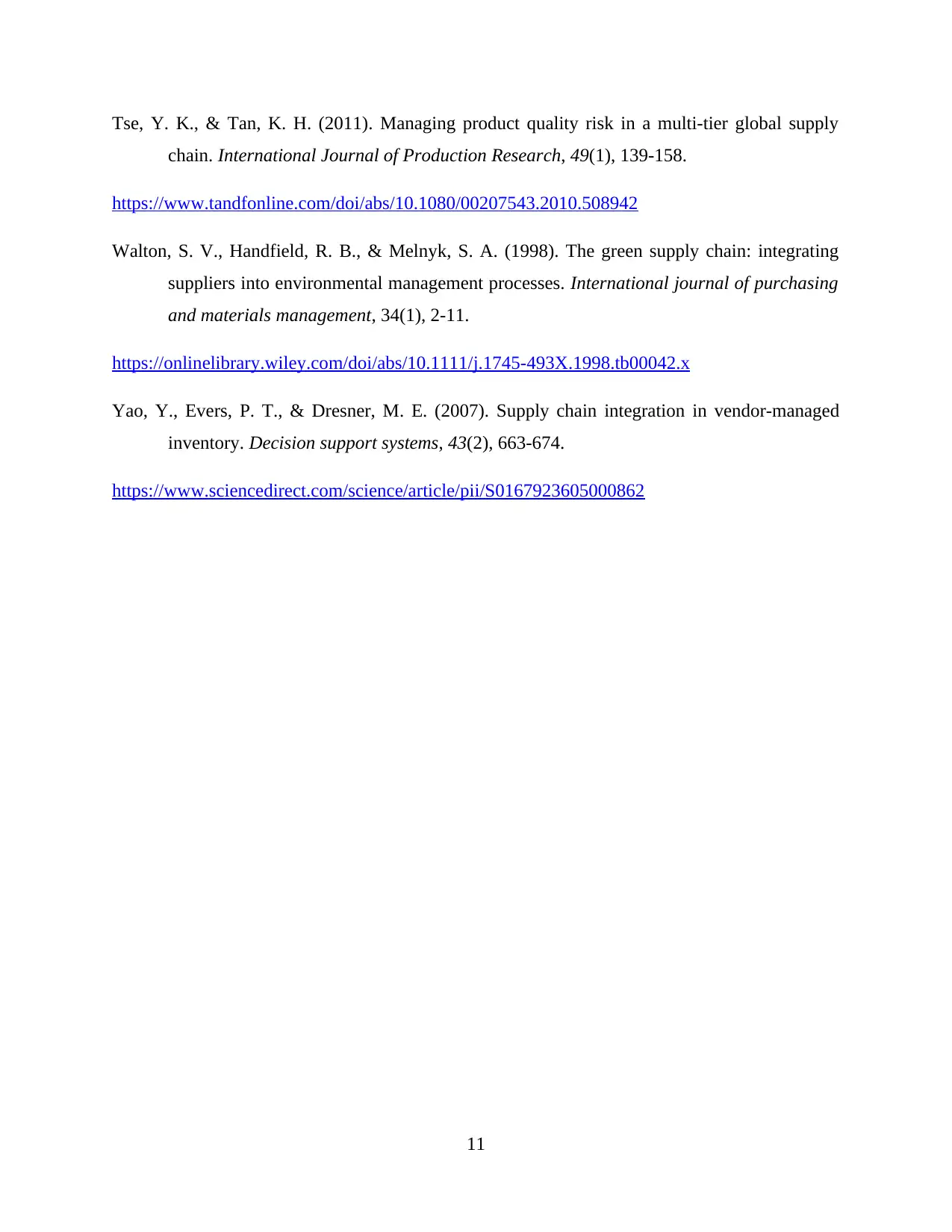
Tse, Y. K., & Tan, K. H. (2011). Managing product quality risk in a multi-tier global supply
chain. International Journal of Production Research, 49(1), 139-158.
https://www.tandfonline.com/doi/abs/10.1080/00207543.2010.508942
Walton, S. V., Handfield, R. B., & Melnyk, S. A. (1998). The green supply chain: integrating
suppliers into environmental management processes. International journal of purchasing
and materials management, 34(1), 2-11.
https://onlinelibrary.wiley.com/doi/abs/10.1111/j.1745-493X.1998.tb00042.x
Yao, Y., Evers, P. T., & Dresner, M. E. (2007). Supply chain integration in vendor-managed
inventory. Decision support systems, 43(2), 663-674.
https://www.sciencedirect.com/science/article/pii/S0167923605000862
11
chain. International Journal of Production Research, 49(1), 139-158.
https://www.tandfonline.com/doi/abs/10.1080/00207543.2010.508942
Walton, S. V., Handfield, R. B., & Melnyk, S. A. (1998). The green supply chain: integrating
suppliers into environmental management processes. International journal of purchasing
and materials management, 34(1), 2-11.
https://onlinelibrary.wiley.com/doi/abs/10.1111/j.1745-493X.1998.tb00042.x
Yao, Y., Evers, P. T., & Dresner, M. E. (2007). Supply chain integration in vendor-managed
inventory. Decision support systems, 43(2), 663-674.
https://www.sciencedirect.com/science/article/pii/S0167923605000862
11
⊘ This is a preview!⊘
Do you want full access?
Subscribe today to unlock all pages.

Trusted by 1+ million students worldwide
1 out of 12
Related Documents
Your All-in-One AI-Powered Toolkit for Academic Success.
+13062052269
info@desklib.com
Available 24*7 on WhatsApp / Email
![[object Object]](/_next/static/media/star-bottom.7253800d.svg)
Unlock your academic potential
Copyright © 2020–2025 A2Z Services. All Rights Reserved. Developed and managed by ZUCOL.





